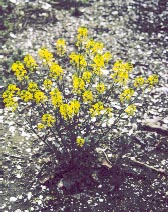Description
Taxonomy
| Kingdom | Phylum | Class | Order | Family | Genus |
|---|---|---|---|---|---|
| Plantae | Magnoliophyta | Magnoliopsida | Capparales | Brassicaceae | Barbarea |
Synonyms
Invasion History
Chesapeake Bay Status
| First Record | Population | Range | Introduction | Residency | Source Region | Native Region | Vectors |
|---|---|---|---|---|---|---|---|
| 1837 | Established | Stable | Introduced | Boundary Resident | Europe | Eurasia | Shipping(Dry Ballast), Agriculture(Agricultural Weed) |
History of Spread
Barbarea vulgaris (Yellow Rocket) is a European plant, found from northern Scandinavia to the Mediterranean (Swedish Natural History Museum 2001), and probably is Mediterranean in origin (MacDonald and Cavers 1991). It was introduced to North America, probably around 1800. By 1848, in the northeast United States, it was reported from 'moist fields and roadsides, common' (Gray 1848). It is now widespread across North America south to FL and AR, and is abundant in the northeast and northwest United States, but patchy in the central United States (United States Department of Agriculture, Agricultural Research Service 1971; MacDonald and Cavers 1991). Barbarea vulgaris is found in most temperate, cultivated regions (MacDonald and Cavers 1991), and is reported from 33 states (Natural Resources Conservation Service 1998).
Barbarea vulgaris is not mentioned in Brereton (1830) for Washington DC, but listed in Aikin (1837) for Baltimore and all subsequent Washington DC-Baltimore floras. It is not usually considered to be an aquatic plant, but it has been reported from the upper parts of oligohaline Brent Marsh, on the Potomac (Strong and Kelloff 1994), and from beach margins in Kent County, MD (Krauss et al. 1971).
History References - Agricultural Research Service 1971; Aikin 1837; Brereton 1830; Gray 1848; Krauss et al. 1971; MacDonald and Cavers 1991; Strong and Kelloff 1994
Invasion Comments
Native Region- Barbarea vulgaris (Yellow Rocket) is now widespread in Europe; still expanding in Russia (MacDonald and Cavers 1991).
Ecology
Environmental Tolerances
| For Survival | For Reproduction | |||
|---|---|---|---|---|
| Minimum | Maximum | Minimum | Maximum | |
| Temperature (ºC) | ||||
| Salinity (‰) | 0.0 | 0.0 | ||
| Oxygen | ||||
| pH | ||||
| Salinity Range | fresh-oligo |
Age and Growth
| Male | Female | |
|---|---|---|
| Minimum Adult Size (mm) | ||
| Typical Adult Size (mm) | ||
| Maximum Adult Size (mm) | ||
| Maximum Longevity (yrs) | ||
| Typical Longevity (yrs |
Reproduction
| Start | Peak | End | |
|---|---|---|---|
| Reproductive Season | |||
| Typical Number of Young Per Reproductive Event |
|||
| Sexuality Mode(s) | |||
| Mode(s) of Asexual Reproduction |
|||
| Fertilization Type(s) | |||
| More than One Reproduction Event per Year |
|||
| Reproductive Startegy | |||
| Egg/Seed Form |
Impacts
Economic Impacts in Chesapeake Bay
Barbarea vulgaris (Yellow Rocket) has had no economic impacts, in Chesapeake bay. It is an important agricultural weed, especially in the Piedmont region (Brown and Brown 1984), but also a nutritious wild 'green' (MacDonald and Cavers 1991).
References- Brown and Brown 1984; MacDonald and Cavers 1991
Economic Impacts Outside of Chesapeake Bay
Barbarea vulgaris (Yellow Rocket) is an important weed of grain, hay, and legume-grass meadows in the northeast United States and southeast Canada (Agricultural Research Service 1971; MacDonald and Cavers 1991). It is included in noxious weed lists of 35 states (Natural Resources Convervation Service 2001).
References- MacDonald and Cavers 1991; Agricultural Research Service 1971; Natural Resources Convervation Service 2001
Ecological Impacts on Chesapeake Native Species
Barbarea vulgaris (Yellow Rocket) is probably too rare and local in the intertidal zone to have had significant impacts, but is an important weed, and a competitor with native plants, in disturbed upland habitats (Brown and Brown 1984).
References- Brown and Brown 1984
Ecological Impacts on Other Chesapeake Non-Native Species
Barbarea vulgaris (Yellow Rocket) is probably too rare and local in the intertidal zone to have had significant impacts, but is an important weed, and a competitor with other exotic plants, in disturbed upland habitats (Brown and Brown 1984).
References- Brown and Brown 1984
References
Agricultural Research Service (1971) Common weeds of the United States., In: (Eds.) . , Washington, D.C.. Pp.Aikin, W. E. A. (1837) Catalogue of phenogamous plants and ferns, native or naturalized, growing in the vicinity of Baltimore, Maryland., Transactions of the Maryland Academy of Sciences and Literature 1: 55-91
Brereton, J. A. (1830) Prodromus of the Flora Columbiana, , Washington, D.C.. Pp.
Brown, Melvin L.; Brown, Russell G. (1984) Herbaceous Plants of Maryland, , College Park. Pp.
Fernald, Merritt L. (1950) Gray's Manual of Botany, In: (Eds.) . , New York. Pp.
Gleason, Henry A.; Cronquist, Arthur (1991) Manual of vascular plants of northeastern United States and adjacent Canada, In: (Eds.) . , Bronx, New York. Pp.
Gray, Asa (1848) A manual of botany of the northern United States., In: (Eds.) . , Boston. Pp.
Harvill, A. M.; Bradley, Ted R.; Stevens, Charles E.; Wieboldt, Thomas F.; Ware, Donna M. E.; Ogle, Douglas W.; Ramsey, Gwynn W.; Fleming, Gary P. (1992) Atlas of the Virginia Flora, , Burkeville, VA. Pp.
Kartesz, John T. (1994) A synonymized checklist of the vascular flora of the United States, Canada, and Greenland., In: (Eds.) . , Portland OR. Pp.
Krauss, R.W.; Brown, R. G.; Rappleye, R. D.; Owens, A. B.; Shearer, C.; Hsiao, E.; Reveal, J. (1971) Checklist of plant species occurring within the hightide limits of the Chesapeake Bay, and its tributaries., , College Park, Maryland. Pp.
MacDonald, Marilyn A.; Cavers, Paul B. (1991) The biology of Canadian weeds. 97. Barbarea vulgaris., Canadian Journal of Plant Science 71: 149-166
1997-2024 USDA PLANTS Database.. Onine databse
Strong, Mark T.; Kelloff, Carol L. (1994) Intertidal vascular plants of Brent Marsh, Potomac River, Stafford County, Virginia, Castanea 59: 354-366
